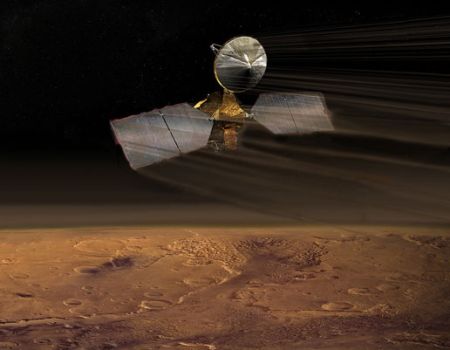JPL Speaker Series: Mars Reconnaissance Orbiter
Today at noon they had the third presentation in JPL’s summer speaker series with Jim Graf on MRO. He’s the project manager. Also from the MRO team was Dr. Richard Zurek, Project Scientist, who I spoke with after the talk. MRO was launched on August 12, 2005 — less than a year ago. I didn’t realize it was so new :) It carries the most powerful camera ever sent to another planet, able to take photos of the surface whose pixels are 30 cm across. This extremely high resolution should allow it to see thet tracks created by the Rovers, and maybe even the Rovers themselves, although they will be only about 9 pixels in size, out of trillions.
MRO reached mars on March 10, 2006, and used a multi-engine burn to slow the craft enough to be captured by Mars’ gravity. For the next 6 months it will use aerobraking to shrink its orbit so that it can get closer to the planet. Aerobraking involves carefully calculated dips into the atmosphere, where friction will slow the speed of the spacecraft. This saves on cost over using additional fuel.

Orbiter in aerobraking stage (artist’s concept)
What interested me most was the data collection aspect. The spacecraft itself has about 160 gigabits of solid-state memory — that’s about 20 GB. Of that, 80 gigabits, or 10 GB, is used for storage of data in queue to be transferred to Earth. The connection to Earth will be about 6 megabits per second, about 4 times the speed of a typical DSL connection, coming all the way from Mars. It will communicate for about 1/3 of each day, 7 days a week, for 2 Earth years (or about 1 Martian year). This will be a massive amount of data, which will be handled by Planetary Data System. This is a network of about 9 datacenters, including Universities as well as Corporations that competed for the spots. They’ll probably transfer data over the Internet. In the past, they used physical CDs, and before that, magnetic tape. But today, the massive amount of data necessitates use of a worldwide network.
The data will be distributed to scientists and students around the world for processing and analysis. They need to make decisions on data compression and transfer. One idea that Zurek told me about is the use of JPEG-2000, which allows a small thumbnail to be sent, and then a section of high resolution imagery to be chosen. None of the previously-transmitted data has to be resent; only the part that the scientists are interested in. Also, formats should be open, not proprietary, to ensure that the data can be used with later computer systems. This reminds me of what Google does. Google is constantly thinking about how to manage and organize huge amounts of data.
On the other hand, the area is completely new to JPL. They have a lot to benefit if they decide to work with Google, because the infrastructure and expertise is not here. You’ll find scientists and engineers here, but no data miners, and certainly not a whole lot in the way of data storage. It seems to me that everyone could benefit if we worked together. But who knows? This is just an idea of mine, not anything that anyone is yet doing.
Many new frontiers are “in-between”; the cutting edge is applying technology from one field into another.
If you’re interested, this could be a great opportunity. See the need and fill it.